Viva Arte Viva! The 57th edition of the oldest and most prestigious contemporary art biennial opened in Venice in May. This year nearly 90 countries participated in the Biennale with their own national pavilions. We had the opportunity to attend the preview days and observe the dynamics that were unfolding. An article about the politics of the preview days of the 57th Venice Biennale was recently published in the Politiikasta webjournal. This blog post focuses on presenting visually the buzzling scene of the Biennale’s preview days.

The national pavilions at the Venice Biennale are located in Giardini, Arsenale and in the city of Venice. Giardini hosts the oldest pavilions, being the original site of the Biennale. However, as the number of participating countries has increased since the 1895, new exhibition sites have been introduced.
Besides national pavilions, the Biennale incorporates a grand International Exhibition that takes place in Arsenale and the Central Pavilion in Giardini. The International Exhibition has usually a special theme and is curated by a recognized curator. This year the humanism-inspired exhibition ‘Viva Arte Viva!’ was curated by Christine Macel, the chief curator of Centre Pompidou. The International Exhibition consisted of nine pavilions titled ‘Pavilion of Artists and Books’, ‘Pavilion of Joys and Fears’, ‘Pavilion of the Common’, ‘Pavilion of the Earth’, ‘Pavilion of Traditions’, ‘Pavilion of Shamans’, ‘Dionysian Pavilion’, ‘Pavilion of Colors’ and ‘Pavilion of Time and Infinity’.
Along the national pavilions and the main International Exhibition, the Biennale includes also official collateral events, organized by museums, private art galleries and geographical entities without an official state status, such as Scotland, Catalonia and Hong Kong. In addition to the official programme, also many unofficial exhibitions and events are happening during the Biennale.
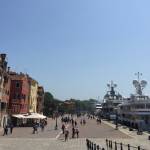
Super yachts lining up at the entrance of Giardini
Giardini
A performance in Giardini
The old shipyard of Arsenale
This year the Russian pavilion had changed its management team, presenting a group exhibition that differed significantly from the three previous editions, when the pavilion was dedicated to a single artist. Now the new commissioner of the Russian pavilion was Semyon Mikhailovsky, the rector of the Repin St. Petersburg State Academy Institute of Painting, Sculpture and Architecture, which is one of the oldest art institutes in Russia. Besides being the commissioner of the Russian pavilion, Mikhailovsky was also the main curator of the exhibition. The exhibition titled ‘Theatrum Orbis Terrarum’ showed works of three artists: Grisha Bruskin, Recycle Group and Sasha Pirogova. Bruskin’s works were presented first, located on the upper floor of the pavilion, while the other two exhibitions were located downstairs. Recycle Group’s work was meant to be viewed using a smartphone, whereas Pirogova’s video work was presented at the end of the exhibition.
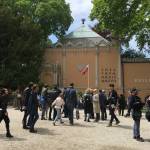
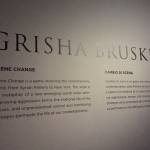

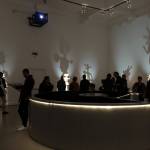
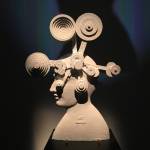
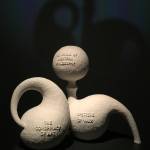
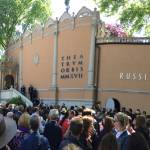 The opening of the Russian pavilion
The opening of the Russian pavilion
The opening of the Finnish pavilion ‘The Aalto Natives’ brought together actors from the fields of art and power. Finnish ambassador in Italy Janne Taalas and the former Minister of Culture Sanni-Grahn Laaksonen gave speeches at the opening. Also the Finnish Embassy in Italy wrote about the Finnish presence at the Venice Biennale (in Finnish).
The American pavilion, located just next to the main café area, attracted a long line of visitors. The Israeli pavilion is located right next to the American pavilion.
Jesus was spotted walking near the Israeli pavilion
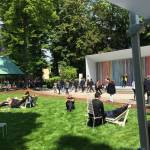
The cafeteria area illustrated the subtle presence of sponsors and the field of commerce: the brightly coloured stage, a popular spot to sip coffee in the sun, was set up to present the new special edition watch by the watchmaker Swatch.
Since the pre-opening, Venice became filled with people carrying black canvas bags that were claiming for indigenous rights and refugee rights. These bags were handed out to the visitors of the Australian pavilion. Noteworthy, the majority of visitors preferred to wear the text ‘indigenous rights’, written with bright yellow letters.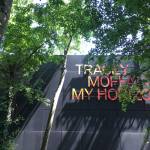
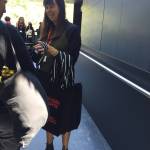
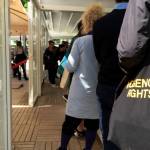
The sponsors of the International Exhibition at the Venice Biennale. Also the Russia-based, privately owned V-A-C foundation was among the main donors, noted for their “generosity”.
An art work by John Waters (2007) in the International Exhibition in the Central pavilion in Giardini.
Besides the national pavilions and the International Exhibition in the Central pavilion, Giardini hosted also open table discussions with art world professionals titled ‘Tavola aperta’.
The sponsors of the Biennale were treating preview visitors with free coffee (illycaffé) and pocket ashtrays (JTI). JTI, Japan Tobacco International, is one of the main sponsors of the Biennale. Often alcohol and tobacco companies are active as art and culture sponsors. The example of JTI also illustrates that a range of actors is using the Biennale to legitimize their actions and secure a “capital of credit”.
Illycaffé held also a separate exhibition in Dorsoduro, dedicated to its special art collection coffee cups that have been designed in collaboration with artists. This also concretizes the character of the Biennale as a site where the fields of art and commerce interact and utilize each other.
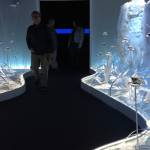
Despite its national pavilions, the Biennale also involves criticism of nation-centered thinking: the Antarctic pavilion based its principles on supranationalism presenting the documentation of the first Antarctic biennale, held earlier this year. Also the NSK state pavilion questioned territorially bounded national spaces, issuing passports for “stateless individuals” and offering public lectures by, for instance, Slavoj Žižek. The posters of NSK state pavilion were found all over the city of Venice.
The Biennale also shows that contemporary art can be used to comment on a variety of issues. ‘John Doe’ at the collateral event exhibition ‘Personal Structures’ by the European Cultural Center criticized the commercial dimension of art and the growth of art investment, i.e. the increasing financialization of contemporary art.
Using art, different pavilions also sent powerful messages against debt and fascism.
The new Venice headquarters of V-A-C foundation, owned by Russia’s richest man Leonid Mikhelson, opened its doors during the Biennale’s preview days. The exhibition at the four-leveled Palazzo delle Zattere consisted of a mix of works by contemporary artists and key Soviet artists from the 1920s and 1930s. The exhibition was organized together with the Art Institute of Chicago. Besides visual arts, also theater and performances were involved. A member of our “Spaces of Justice” research project, Olga Jitlina participated in the exhibition with her play ‘Translation’. Taus Makhacheva in turn organized a performance that referred to the famine in Ukraine and Caucasus in the 1930s.

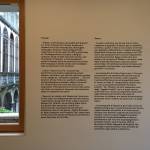
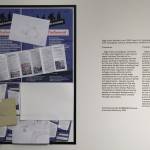
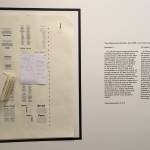
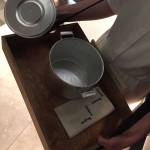

 Also Damien Hirst, one of the most well-known and controversial contemporary artist, attempted to benefit from the ‘Venice effect’. Hirst’s grand comeback exhibition, which did become a popular spot among the preview crowd at least, was presented in both Palazzo Grassi and Punta della Dogana, owned by François Pinault, a French businessman, art collector and owner of Christie’s auction house. This strategic attempt to gain visibility for Hirst’s exhibition by presenting it during the Biennale illustrates the role of Venice and the Biennale as an important mechanism for the accumulation of symbolic capital.
Also Damien Hirst, one of the most well-known and controversial contemporary artist, attempted to benefit from the ‘Venice effect’. Hirst’s grand comeback exhibition, which did become a popular spot among the preview crowd at least, was presented in both Palazzo Grassi and Punta della Dogana, owned by François Pinault, a French businessman, art collector and owner of Christie’s auction house. This strategic attempt to gain visibility for Hirst’s exhibition by presenting it during the Biennale illustrates the role of Venice and the Biennale as an important mechanism for the accumulation of symbolic capital.
This year a Research pavilion was opened on the island of Giudecca, created and hosted by the UniArts Helsinki. Already the trip to the pavilion could be seen analogical to the practice of doing research: one needs to make an effort to get there.
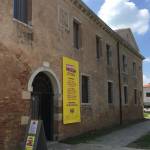



The academic karaoke (pictured here with Finnish subtitles) reminded about the duty of science to share the knowledge with the society.

During the preview days we also visited many social events such as the opening of the State Pushkin Museum’s debute official collateral event exhibition, the nightclub-like evening reception of the Russian pavilion and the Biennial Foundation’s reception, organized in the neighboring villa next to the Peggy Guggenheim museum. Also Pinchuk Art Centre’s reception party was a popular destination for many Biennale preview visitors. The opportunity to meet and connect with the international art professionals and art enthusiasts at various social events seemed like a valuable element of the Biennale. The Biennale can provide a platform for international cultural relations and cultural diplomacy as the different international actors mingle with each other at the various exclusive parties.
The sponsors were visibly present at the Russian reception.
Pinchuk’s Future Art Prize party gained the visitors’ attention with its loud music and bright lights in the Venetian night.
The Biennale provides an opportunity to gain attention of the prominent art world actors, which is why the unofficial programme of the Biennale is also rich with different events.
We also participated in a performance organized by a Moscow-based creative collective Laboratory ABC, which aims to connect companies and cultural organizations by “bridging the gap between art and business”. Indeed, Simple, the sponsor of the event and one of the leading wine distributors in Russia, played a visible role at the spectacular performance site of Scuola Grande di San Giovanni Evangelista.
Regardless the hectic, action-packed marathon-like preview days, Venice did also occasionally manage to charm visitors with its serene beauty. La Serenissima, as they say!



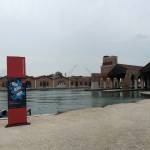
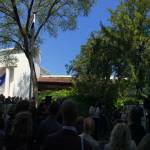
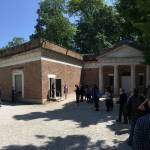
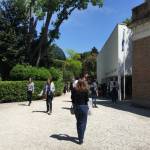
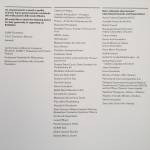

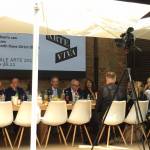
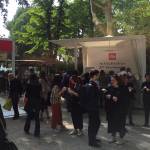
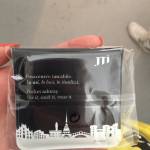
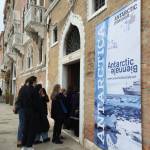
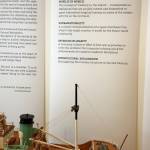
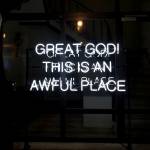
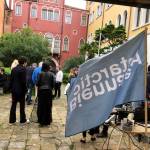
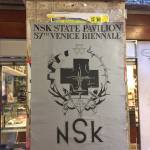
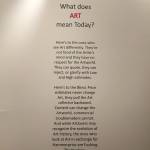
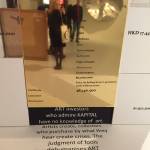

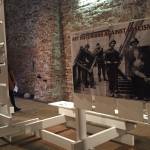
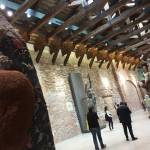
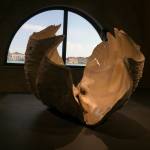

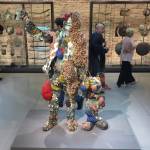
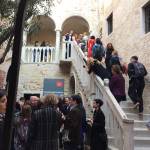
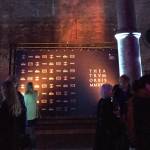
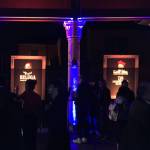
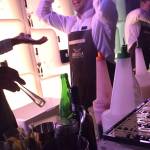
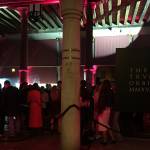

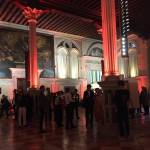


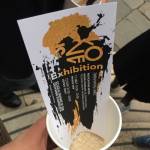
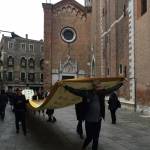

Comments